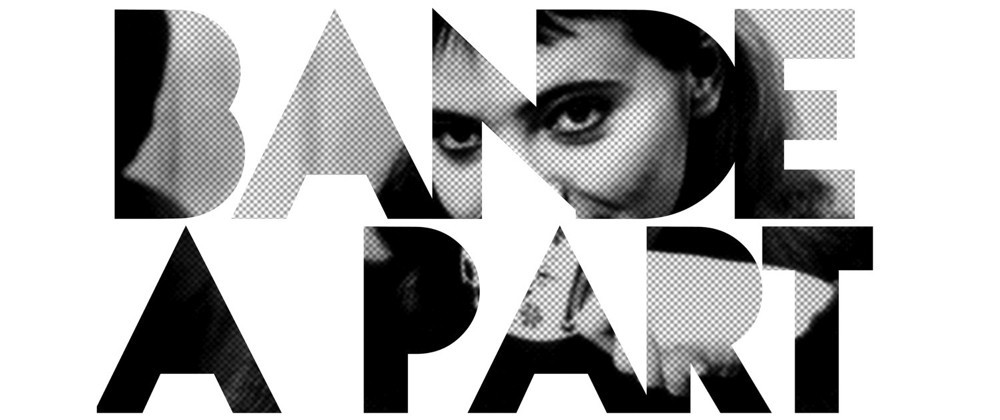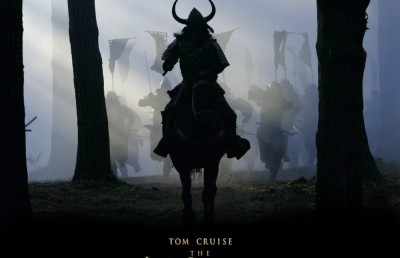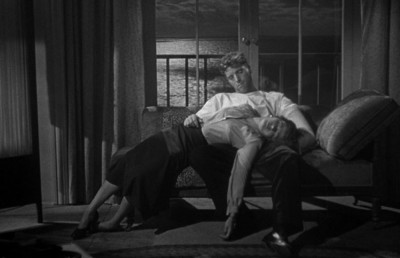Band à part
2004 Re-release

Fans of early Godard can rejoice in the Rialto Pictures summer 2004 re-release of a new 35mm print of Band à part, showing at Montreal’s Cinema du Parc from June 4-10. Jean-Luc Godard’s seventh feature is, arguably, his final purely joyous New Wave film before moving on to his more formally abstract and politically radical works of the late sixties and early seventies. The print is in stunning shape, and belies the notion that a dirty, scratched prints ‘add’ to the realist factor of a film. Not that Band à part makes any claims to be a realist film, far from it, but that a crisp, clean print of an old black and white film adds to the veracity of time and place, making the streets and cafes of pre-1968 Paris, captured by Raoul Coutard’s hand-held camera and natural lighting (in the exterior scenes), more vivid for a contemporary audience.
The most formally radical element of Band à part is its opening flicker effect credits, which fly by in 2-4 frame alternations of the three principal characters. After this opening the film settles into a fairly linear narrative, one that is less elliptical than most of his previous efforts and grounded in one of the strongest (i.e. most conventional) narratives of any Godard film. The story concerns two bored, unemployed male companions, Arthur (Claude Brasseur) and Franz (Sami Frey), who befriend an equally bored young lady named Odile Monod (Anna Karina). Odile informs them of a stashed loot in the villa where she lives with her guardian/aunt Madame Victoria (Louisa Colpeyn). They haphazardly plan the robbery but bungle it in the most nonchalant manner imaginable. When they enter the villa they act more like guests who have arrived early for dinner than thieves! The triangular relationship, established early during an English class scene by a wonderful exchange of glances and camera movements, is reminiscent of Truffault’s 1962 Jules et Jim, and like this latter film, the relationship ends in tragedy, with Arthur dying in a shoot-out with his cousin at the scene of the crime.
The film, based on the American pulp novel Fool’s Gold by Dolores Hitchens, owes much to the American B films; as Godard the narrator informs us as they plan the crime, “Out of respect for second rate thrillers, they won’t do the job until nighttime.” From today’s vantage Band à part is a film poised between the classic American auteurist and B-movies of the thirties to the fifties and the subsequent cinephilia which came after it in peaks and valleys from the sixties onwards. Band à part is filled with filmic homages and reference points for Godard. In turn, Band à part becomes a referenced “intertextual” text for many post-1970 filmmakers.
To begin with Band à part, there are many references to the American gangster film: Arthur’s stylized fake death apes both Jean-Paul Belmondo’s death in A Bout de souffle, which was already a parody/homage to James Cagney’s death in The Roaring Twenties; while Arthur’s nudging Odile on the chin with a light punch is a Cagney trademark (as Belmondo’s finger across the lip was to Bogart). In an early car scene the camera remains in the back seat filming Odile and Franz from behind in a long take reminiscent of the extended sequence shot car scene from Gun Crazy (1949, Joseph H. Lewis).
There are also moments in Band à part which foreshadow later Godard. For example, during the English class scene we see the following words written on the school board “classic = modern”. The equation on its own can signify the New Wave project in its entirety, “modernizing” classic cinema. The chalkboard as a site for slogans or intellectual jokes would be a common trope in later Godard films, nowhere more effectively than in a scene from La Chinoise (1965) where a character walks up to a chalkboard filled with the names of intellectuals and artists and erases them one by one until one name remains, Brecht. In a brief night-time city scene a large neon store front sign reading “Nouvelle Vague” stands as the only reason for the scene’s inclusion.
Stylistically Band à part varies from highly edited scenes to scenes that are covered with one or two long takes. Even this becomes a playful element in Godard’s hands. A long 7-8 minute café scene where the three characters sit at a table to plan the heist is handled with a static camera fixed at a distance. However, there is a hidden cut at the point where Odile stands and walks past the camera (perhaps a reference to the master of this type of hidden cut, Alfred Hitchcock?). During this same scene one of the characters suggests they remain quiet to prove that “a minute of silence can take forever.” This moment becomes a double reflexive gesture. Godard cuts off the sound entirely, making the audience complicit in the moment of silence; secondly, the ‘minute’ of silence ends up being about 40 seconds, Godard’s way of saying that in cinema nothing can be trusted, not even ‘real time.’
At one point Odile informs us that she hates cinema, theatre, dancing, and walking, and only loves nature. This is ironic since it appears to be Godard’s own sentiments in reverse. His on-location, urban-based films are full of art references and rarely extol the beauty of nature (only if glimpsed in an impressionist painting). However, this would change in Godard’s later works, which are informed by a much greater textual interest in nature (for example, in Prénom Carmen 1983, Nouvelle vague 1990, Allemagne Année 90 Neuf Zéro 1991, and JLG by JLG 1995).
To conclude, Band à part (and Godard in general) has been a touchstone for many post-1970 filmmakers. Film buff turned film auteur Quentin Tarantino has gone as far as name his production company “A Band Apart”. A key scene in Band à part remains the dance scene in the café, where the three characters do an impromptu “Madison” line dance to a jukebox. The scene is one of Godard’s simplest and most enjoyable moments of pure cinema (and as we learn from the Criterion DVD, was shot in one take). Uma Thurman’s dance in the 1950’s retro diner scene in Pulp Fiction is a direct homage to the dance scene in Band à part; and the dance scene was also referenced by Hal Hartley in Simple Men (1992). It is fitting that one of the most recent references to Band à part is from Bernardo Bertolucci’s The Dreamers (2004), a film which is set in Paris 1968 and deals with the political commitment of a group of cinephiles. Bertolucci’s intertextual reference to Band à part is especially fitting because he represents an ongoing discourse between the New Wave and today. As a young, politically engaged Italian filmmaker ten years his junior, Bertolucci was a huge admirer of Jean-Luc Godard in the early sixties. Bertolucci had a celebrated falling out with Godard during Godard’s radical Dziga-Vertov period. However, time is the great healer, and Godard is once again a hero of sorts in The Dreamers. There are several Godard extracts in The Dreamers, but one famous scene from Band à part is given the privilege of being replayed by the young “trio” in The Dreamers. The scene in question is when Odile, Arthur and Franz attempt to beat the record time of visiting the Louvre, 9’45” held by an American named Jimmy Johnson (or so Odile tells us). They proceed with the Dadaist, anti-bourgeois prank and pip the record by 2 seconds. In keeping with the original, Bertolucci’s trio breaks the record.
Shot in 25 days on a budget of $120,000, Band à part is a New Wave classic made during the middle of De Gaulle’s 5th Republic (1958-1969) which, from the standpoint of what came after, both in terms of French society and Godard’s own cinematic progress, seems like a hang-over from a bygone innocent era.














